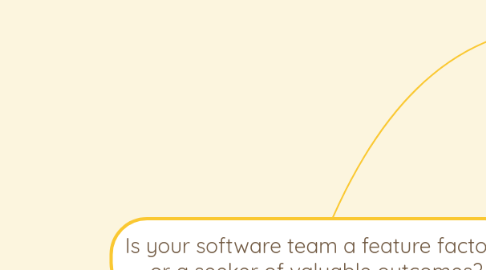
1. Reasons why many features don't "cut the mustard"
1.1. 1. the feature is internally over-rated
1.1.1. i.e., the feature doesn't hold up to scrutiny from real users
1.1.1.1. we find out that other people think our baby is actually ugly or at least not as beautiful as we perceive it to be
1.1.1.2. concretely, the feature doesn't deliver the value that we forecasted
1.2. 2. the feature is difficult or over-complicated to use
1.2.1. i.e., users find using the feature more trouble than it's worth
1.2.1.1. the actual experience of the user doesn't fit the bill
1.3. 3. the differentiator of the feature is costly to implement
1.3.1. i.e., the true value-add of the feature is much more expensive to implement than first thought
1.3.1.1. even if we know customers would absolutely love it, we discover that we can't afford the time and money to deliver the true differentiator
2. A Product Roadmap is essentially a prioritised list of features
2.1. That's useful BUT
2.1.1. It's not sufficient to ensure that those features are making the intended impact
2.1.1.1. i.e., positively changing the behaviour of the target audience towards the desired outcome
2.2. Why is it not sufficient?
2.2.1. A high priority feature doesn't guarantee a positive return on investment
2.2.1.1. “Ronny Kohavi ... reveals ... 60%–90% of ideas do not improve the metrics they were intended to improve. Based on experiments at Microsoft, 1/3 of ideas created a statistically significant positive change, 1/3 produced no statistically significant difference, and 1/3 created a statistically significant negative change.” – Lean Enterprise by Jez Humble; Joanne Molesky; Barry O'Reilly
2.2.1.2. “... of course there is some bias in that experiments are run when groups are less sure about an idea, but this bias may be smaller than most people think; at Amazon, for example, it is a common practice to evaluate every new feature, yet the success rate is below 50%.” – Online Experimentation at Microsoft by Kohavi et al
2.2.1.3. “All of the ideas tested were thought to be good ones—but neither intuition nor expert opinion are good gauges of the value our ideas have for users.” – Kohavi et al
3. Will you choose the BLUE or RED Pill?
3.1. The RED pill means
3.1.1. you face the tough realities of the feature scrap yard and seek to be ruthless around your loyalty to features that don't deliver
3.1.1.1. How?
3.1.1.1.1. take an experimental test-and-learn approach to validate your assumptions early and often
3.1.1.1.2. focus on how you are changing the behaviour of the target audience towards the desired outcome rather than delivering pieces of functionality
3.1.1.1.3. don't be afraid to toss a feature into the scrap yard and move on
3.2. The BLUE pill means
3.2.1. you can return to the bliss and diligence of maximising the output from your feature factory!
3.2.1.1. How? (sarcastic)
3.2.1.1.1. Keep calm and carry on!
3.2.1.1.2. Ignore the data around low performing features
3.2.1.1.3. Keep adding features as if they are all equal and don't decommission anything, just in case someone may be impacted
